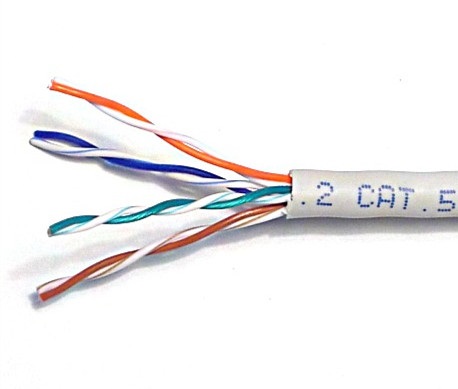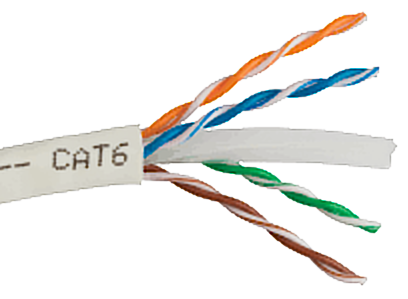Even though WiFi is a great way to easily connect all of your devices wirelessly to the internet, it still has many performance reliability issues. And this is despite having newer available WiFi versions like WiFi 5 and WiFi 6. While these certainly offer high performance, the range is still an issue. Because of this, a wired Ethernet connection is still considered to be a great performance option for high-performance networking where you want high transfer speeds and reliability.
Although, not all Ethernet versions out there are the same since they can differ in terms of their performance numbers. And since two of the most popular Ethernet versions are Cat 5 and Cat 6, we are here with a complete comparison between Cat 5 Vs Cat 6. You can simply go through all the following details to learn everything about Cat 5 and Cat 6 Ethernet versions:
Outline
ToggleWhat is Cat 5?
Cat 5 is a type of Ethernet cable which is quite old and popular since it has been around for a long time. It is a general-purpose LAN Ethernet cable type that is used for connecting most computers to any given internet. This is due to the reason that at the time of its introduction, it was quite fast.
It can offer up to 100 Mbps speeds with a bandwidth of 100 MHz which is decent enough for connecting to the internet. Although, for faster internet connections and faster file sharing, Cat 5e was introduced, where e stands for enhanced. With that, its speeds were improved to 1 Gbps which is similar to Cat 6 as you will see down below.
What is Cat 6?
As you can expect by the name, Cat 6 is the newer and the better version of Ethernet, which performs much better than Cat 5. No matter what length you are using for Cat 6, you will always get 1 Gbps speeds with it. And if you are looking for a cable made for high-speed networking, then you can also achieve 10 Gbps at a distance of up to 55 meters with Cat 5.
Even though it uses the same connector as Cat 5, it is able to offer higher speeds due to the higher quality materials inside and the better bandwidth. Similar to Cat 5, Cat 6 also has a better version called Cat 6A which can offer higher 10 Gbps speeds at over 100 meters with ease.
Difference between Cat 5 and Cat 6
Since we have already discussed most of the details regarding Cat 5 and Cat 6 cables up above, you must already have a pretty good idea about their differences. But in case you want to know more, then there is still a lot to consider. Hence, we are here with all the detailed differences between Cat 5 and Cat 6 as shown here:
Bandwidth of Cat 5 and Cat 6
The major difference between a Cat 5 and Cat 6 is in their performance. This simply means that they both have completely different bandwidth or transfer speed ratings. While Cat 5 can only go up to 100 Mbps in terms of its transmission speeds, Cat 6 offers up to 10 Gbps. Since this bandwidth is much higher, it is the better option for faster internet connections and local file transfers.
Frequency of Cat 5 and Cat 6
Another difference between Cat and Cat 6 is that they use different frequencies for signal transfers. Starting with Cat 5, it relies on 100 MHz frequency which is a bit slow. This frequency is handled via the older 1000Base-T/TX standard, which has limited performance numbers. On the other hand, Cat 6 can go up to 250 MHz frequency for much better performance, especially when combined with its newer 10GBASE-T standard.
Safety Margins
If you are using Ethernet cables for industrial usage, having safe to use cables is quite important. For the same, Cat 6 uses a thicker plastic casing in comparison to Cat 5. As a result, it has better protection against any crosstalk issues. This helps in maintaining high transfer speeds when using long-distance Ethernet cables.
Backward Compatibility
Upgrading to Cat 6 should be fairly easy as it is fully compatible with Cat 5 devices without any issues. Although, you will still get only Cat 5 speeds with Cat 5 devices even if you are using a Cat 6, which is something you need to keep in mind.
Future of Data
In case you are building a network to be used for a long period of time, it is quite important to have it ideal for future usage. Since Cat 5 is slow and not ideal for long-distance usage, Cat 6 is the much better option when it comes to future-proofing.
Cat 5 vs Cat 6: Comparison Chart
| Cat 5 | Cat 6 | |
| Bandwidth | Up to 100 Mbps | Up to 10 Gbps |
| Frequency | Up to 100 MHz | Up to 250 MHz |
| Safety Margins | High chances of crosstalk | Low chances of crosstalk |
| Backward Compatibility | Equally compatible | Equally Compatible |
| Future of Data | Limited usage in future | Future proof cable |
Similarities between Cat 5 vs. Cat 6 Cables
Even though there are a lot of differences between Cat 5 and Cat 6 cables, they also have a few similarities. This is due to the reason that both of them are Ethernet cable types and made for the same functions. The major similarity between these cable types is that they both use the RJ-45 connector. This plug consists of a total of 8 gold-plated connectors which are the same in both of them. Because they use the same physical connector, they can be used within the same network without any compatibility issues.
Conclusion: Cat 5 vs Cat 6
Upon checking all these details regarding Cat 5 and Cat 6, you must know almost everything about these Ethernet versions. And since we have stated a complete comparison between Cat 5 and Cat 6 up above, you can easily choose the right one for you. Unless you have any incompatible devices, Cat 6 is the much better option in terms of the performance numbers that it offers to the user.
If you have gone through this Cat 5 vs. Cat 6 comparison, make sure to share your thoughts in the comments section. You can also post any questions down there if you have any!



